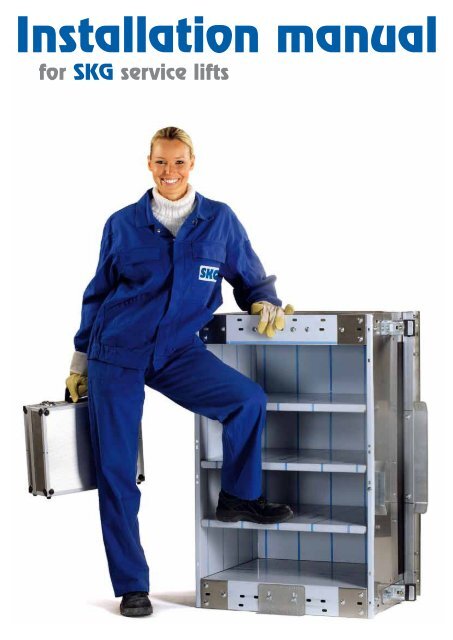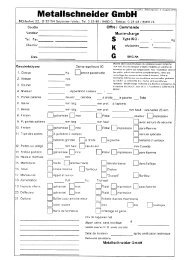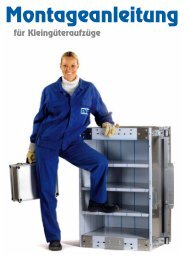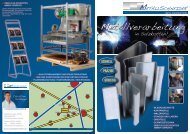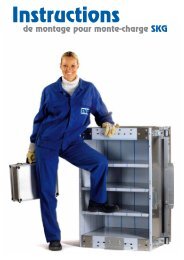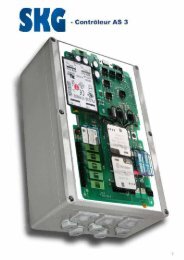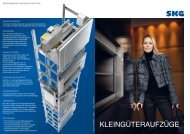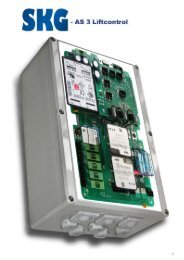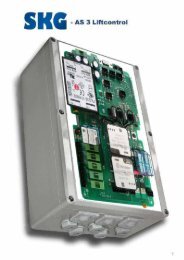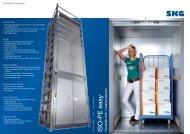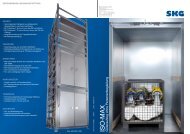Installation manual for service lifts
Installation manual for service lifts
Installation manual for service lifts
Create successful ePaper yourself
Turn your PDF publications into a flip-book with our unique Google optimized e-Paper software.
<strong>Installation</strong> <strong>manual</strong><br />
<strong>for</strong> SKG <strong>service</strong> <strong>lifts</strong>
Preliminary remarks<br />
The existing shaft dimensions need to be<br />
checked <strong>for</strong> con<strong>for</strong>mity with the layout<br />
drawings. In case of deviations, please make<br />
a technical clearification with us be<strong>for</strong>e the<br />
installation process.<br />
The installation must be made in<br />
compliance with the relevant safety<br />
standards.<br />
Don‘t stand underneath the<br />
unsecured cabin.<br />
Danger of life!<br />
This installation <strong>manual</strong> is a recommendation<br />
based on our experience, it is not a working<br />
instruction.<br />
Please take the installation details from our<br />
layout drawings. Front side, which is side X<br />
on the layout drawings, always means the<br />
side on which the machine room door is<br />
positioned. Please install along the described<br />
order in this <strong>manual</strong>.<br />
Deviations to these photos are always<br />
possible due to technical variations.<br />
Table of contents<br />
3 <strong>Installation</strong> order<br />
4 - 5<br />
6 - 7<br />
8 - 14<br />
15 - 21<br />
22 - 29<br />
30 - 32<br />
33 - 35<br />
View example<br />
Accessories<br />
Structure<br />
Cabin<br />
The controller is delivered in a separate box.<br />
Next to this installation <strong>manual</strong>, you will also<br />
find in the box:<br />
A Wiring diagrams<br />
B Capacity signs<br />
C Operation <strong>manual</strong><br />
D Layout drawings<br />
All bolted connections need to be fastened<br />
with the torques as mentioned in the table:<br />
strength class 8.8<br />
Fastening torques of<br />
all screws<br />
M 4 5 Nm<br />
M 5 7,1 Nm<br />
M 6 12 Nm<br />
M 8 30 Nm<br />
M 10 60 Nm<br />
M 12 105 Nm<br />
Exception: the round-head screws M 8 need<br />
to be fastened to 25 Nm.<br />
Drive machine, machine supporter and divertor unit<br />
Doors<br />
Electrical components<br />
1.<br />
2.<br />
3.<br />
4.<br />
5.<br />
6.<br />
7.<br />
8.<br />
9.<br />
10.<br />
11.<br />
12.<br />
13.<br />
14.<br />
<strong>Installation</strong> of the bottom structure part<br />
<strong>Installation</strong> of the safety bar<br />
Inserting the cabin<br />
Inserting the counterweight<br />
<strong>Installation</strong> of the other structure parts<br />
<strong>Installation</strong> of the machine supporter<br />
<strong>Installation</strong> of the drive machine<br />
Inserting the suspension elements<br />
<strong>Installation</strong> of the landing doors<br />
<strong>Installation</strong> of the controller<br />
<strong>Installation</strong> of the shaft electrics<br />
Check of overrun<br />
Put lift in operation<br />
Security-related final check<br />
<strong>Installation</strong> order<br />
3
4 View example<br />
5<br />
Counterweight side <strong>Installation</strong> side<br />
Controller<br />
Main switch<br />
Drive machine<br />
Double hinged machine room door<br />
Pulley supporter<br />
Protective grid on sheave<br />
Structure strap<br />
Machine room lightning<br />
Top part of structure<br />
Ropes<br />
Push button element<br />
Guide rail<br />
Emergency release key<br />
Bi-parting door<br />
Structure strap<br />
Structure strap<br />
Structure diagonal<br />
Electrical bridge<br />
Safety bolt on weight<br />
Cabin<br />
Counterweight with weight inserts<br />
Structure strap<br />
Emergency stop switch<br />
Push button element<br />
Trailing cable<br />
Safety bar<br />
Guide rail<br />
Bi-parting door<br />
Bottom structure part<br />
Structure strap<br />
Structure diagonal<br />
Safety bar
6 Accessories<br />
7<br />
Structure bracket<br />
215 x 35 x 3 mm<br />
Locking plate<br />
<strong>for</strong> guide rail<br />
160 x 48,5 x 2 mm<br />
Clamp plates<br />
<strong>for</strong> structure straps<br />
50 x 50 x 3 mm<br />
Connection piece<br />
<strong>for</strong> guide rail<br />
160 x 45 x 3 mm<br />
Balance plate<br />
90 x 90 mm<br />
Straight wall<br />
anchor<br />
135 x 35 x 3 mm<br />
Scale 1:1<br />
Hexagon bolts M 10x30<br />
Contact washers A 10,2<br />
Hexagon bolts M 10<br />
<strong>for</strong> machine supporter and drive machine<br />
Wooden wedges<br />
as installation support<br />
Emergency release key<br />
Self-locking nuts M 8x16<br />
Round-head screws M 8x16<br />
Washers A 8,4 DIN 9021<br />
<strong>for</strong> structure straps / brackets<br />
diagonals / foot brackets / wall anchors<br />
Woodscrews 8x70<br />
PVC-dowels S 12<br />
Washers A 8,4<br />
<strong>for</strong> structure fixing<br />
Hexagon nut M 8<br />
Contact washers A 8,2<br />
<strong>for</strong> structure brackets / structure straps<br />
and guide rails<br />
Foot brackets<br />
<strong>for</strong> structure fixing to ground<br />
Metal plate<br />
<strong>for</strong> guide rail<br />
100 x 40 x 1,25 mm Safety bar GV 36<br />
with chain<br />
Wall anchors 90° folded<br />
85 x 55 x 35 x 3 mm<br />
Hexagon screws M 8x20<br />
<strong>for</strong> structure brackets / structure straps<br />
and guide rails<br />
Washers A 8,4 DIN 125<br />
<strong>for</strong> structure brackets
8 Structure<br />
9<br />
Structure straps<br />
Left structure part<br />
on counterweight<br />
side<br />
Bottom<br />
structure part<br />
The structure consists of the right and left structure<br />
parts, the structure straps and the structure diagonals.<br />
The cable conduits and the guide rails are pre-installed<br />
on the structure parts.<br />
Structure diagonal<br />
(short)<br />
Bottom structure part<br />
(red painted)<br />
Structure diagonal<br />
(long)<br />
Right<br />
structure part on<br />
installation side<br />
Structure<br />
diagonal<br />
Structure strap<br />
Top part of structure part<br />
on counterweight side<br />
Structure part<br />
on counterweight side<br />
Guide rails<br />
Top part of structure<br />
on installation side<br />
Cable conduit<br />
Structure part<br />
on counterweight side<br />
Please consider that the cabin needs to be inserted in the guide rails. We recommend to insert the cabin<br />
with a suitable hoist after the installation of the first structure parts. Please make sure that the structure<br />
parts with the elongated hole row (U-profile) is mounted on the counterweight side.<br />
In the following, the structure side with the U-profile is called counterweight side. The structure side<br />
with the L-profile is called installation side.<br />
Counterweight side<br />
(U-profile with elongated hole row)<br />
<strong>Installation</strong> side<br />
(L-profile)<br />
Please adjust the support points be<strong>for</strong>e positioning the bottom, red painted structure parts. The difference<br />
in height is to be adjusted by balance plates.<br />
Structure bracket<br />
Guide rail<br />
Metal plate Locking plate
10 Structure<br />
11<br />
The structure straps are to be screwed together with the structure parts as shown on the photos.<br />
Each structure part with 2 m length is to be rein<strong>for</strong>ed with a structure diagonal.<br />
The safety bars are to be installed with 2 pieces M 6 screws on the bottom structure part guide rails. This<br />
kind of safety bar is available only when the cabin is not equipped with buffers. The narrow safety bar is to<br />
be fixed on the counterweight side (U-profile), the wide safety bar on the installation side (L-profile).<br />
(narrow) safety bar<br />
on the counterweight side<br />
Counterweight side <strong>Installation</strong> side<br />
(wide) safety bar<br />
on the installation side<br />
Sliding brackets are pre-installed on top of the structure parts. These serve as additional structure brackets<br />
<strong>for</strong> the further fixing of the structure parts.<br />
Pre-installed<br />
sliding bracket<br />
Misplaced<br />
sliding bracket<br />
The sliding bracket is to be inserted into the end of the guide rail. This facilitates the alignment of the guide<br />
rails. The guide rail ends are to be screwed together with 2 connection pieces. These screws should be<br />
tightened after the alignment of the guide rails.<br />
Guide rail<br />
Metal<br />
sheet<br />
2 connection pieces<br />
Sliding bracket<br />
Structure<br />
bracket<br />
Be<strong>for</strong>e the installation of the top<br />
structure part, the counterweight<br />
must be inserted in the U-profile.<br />
Counterweight<br />
U-profile<br />
Structure bracket
12 Structure<br />
13<br />
The counterweight is adjustable between the guides. Unscrew the screws of the frame <strong>for</strong> inserting the<br />
counterweight inserts. After inserting, the screws must be tightened again.<br />
Adjustment<br />
of the counterweight<br />
Insert the weight inserts in a zigzag<br />
Safety bolt weight<br />
When the complete structure is installed, it is to be plumb adjusted with the wooden wedges and then fixed<br />
securely with the wall anchors, dowels and screws. The screw joint in the brickwood only serves <strong>for</strong> the<br />
fixing of the spacers (wall anchor and foot bracket). The screws must not be loaded on strain.<br />
Wall anchor<br />
You must load<br />
the screws<br />
on strain!<br />
The safety bar (yellow) is to be fixed on the structure with the chain. On all works in the shaft, the safety<br />
bar must be put in the structure between 5 to 25 mm next to the guide rail at a minimum height of 1,8 m<br />
<strong>for</strong> blocking the cabin and the counterweight.<br />
Rear guard plates (optional)<br />
Special features on different constructions<br />
The rear guard plates are to be screwed together with the structure straps on the opposite side of the<br />
landing doors. On through-car lift cabins, they prevent that the goods projecting the shaft structure. The<br />
rear guard plates need to be installed at the same time as the the structure straps. When installing the rear<br />
guard plates retrospectively, the stucture straps must be removed from the rear guard plates.<br />
Rear guard plates<br />
Put in the safety bar on<br />
all shaft works correctly.<br />
Otherwise:<br />
Danger of life!<br />
Rear guard plates<br />
Counterweight side
14 Structure<br />
Cabin 15<br />
Baffle plates (optional)<br />
The baffle plates (optional) are to be installed on the structure to the full travel height. As a support, 2<br />
brackets are bent, so the baffle plates can be hooked on the structure straps. Then the baffle plates are<br />
screwed with the drilling bolts ø 4,2 x 16 onto the structure straps.<br />
Baffle plate sheet Bending the bracket<br />
Safety gear (optional)<br />
On <strong>lifts</strong> with safety gear, the guide rails are made of blank steel. On this construction, the alignment sheets<br />
are not applicable. There is no need <strong>for</strong> the balance weight. A govenor tension weight will be installed<br />
instead.<br />
Shaft partition wall (optional)<br />
Guide rails<br />
made of blank steel<br />
A shaft partition wall needs to be installed if 2 lift units are sharing a common shaft. Only then, a shaft<br />
partition wall is delivered with the lift. You can see on the layout drawings to which lift unit the shaft partition<br />
wall has been packed.<br />
The cabin is pre-installed. It needs to be inserted with a suitable hoist into the guide rails. The cabin guide<br />
shoes can be adjusted inside the holding brackets with the M 10 screws. The retiring cam <strong>for</strong> opening the<br />
landing doors is positioned on the installation side.<br />
Only on 2 stops, a further control cam <strong>for</strong> the floor switches is installed at the side.<br />
Cam <strong>for</strong> opening<br />
the landing doors<br />
Cam<br />
<strong>for</strong> the floor switches<br />
Cam <strong>for</strong> opening<br />
the landing doors<br />
Only on <strong>lifts</strong> with more than 2 stops, a holding metal sheet with adjustable magnets is used. The holding<br />
metal sheet with the magnets replaces the floor switch cam.
16 Cabin<br />
17<br />
The cabin apron is to be fixed with the round-head screws to the lower cabin stripe (not applicable on cabin<br />
door).<br />
Cabin apron<br />
Cabin stripe<br />
The trainling cable fixing is to be installed center the cabin and then to be fixed with clamp plates to the<br />
stripes at the side.<br />
Clamp plates<br />
Trailing cable fixing<br />
Trailing cable<br />
A trailing cable is applicable only if safety switches or electrical retiring cams (EMT14 or 15) are installed on<br />
the cabin. Please see wiring diagrams.<br />
The riding on the cabin ceiling is strictly <strong>for</strong>bidden! You are only allowed to step onto the cabin ceiling<br />
(see EN81-3 0.3.12.1). There<strong>for</strong>e, the safety rope on the cabin must be put around the guide rail and must<br />
be secured with the shackle. The electrical bridge next to the emergency stop switch will be opened when<br />
necessarily so the safety circuit is open.<br />
Electrical<br />
bidge<br />
Closed electrical bridge Opened electrical bridge<br />
Safety rope<br />
Shackle<br />
Special features on different constructions<br />
ISO-A (Bi-parting doors on serving height)<br />
The landing doors will be unlocked by a fixed type cam. There are 2 types of door locks without fail safety<br />
device: TV90 and TV3074.<br />
Fixed type cam<br />
Riding <strong>for</strong>bidden!<br />
ISO-C (Bi-parting doors with serving height lower than 700 mm)<br />
The landing doors will be operated by an electrical retiring cam (EMT 15). The door lock with fail safety<br />
device is called TV90a.<br />
Electrical retiring cam
18 Cabin<br />
19<br />
ISO-D (Swing doors serving at floor level)<br />
The landing doors will be operated by an electrical retiring cam (EMT 14).<br />
Drive machine with chain wheel or rope drum<br />
The cabin is equipped with an additional switch activation cam <strong>for</strong> the control current limit switch. The<br />
additional safety switch is activated automatically if the floor limit switch fails. The position (left or right) of<br />
the control current limit switch depends on the cabin depth.<br />
Cabin shelf<br />
Activation cam<br />
<strong>for</strong> control current limit switch<br />
Activation cam<br />
<strong>for</strong> floor switch<br />
Activation cam<br />
<strong>for</strong> control current<br />
limit switch<br />
Special features on different constructions<br />
The cabin shelves need to be layed on the plastic rings in the cabin to prevent any<br />
slipping.<br />
Heated cabin shelf, cabin floor or cabin ceiling<br />
Heated cabin shelves are screwed inside the cabin ceiling and can not be taken out. The switch / switches<br />
<strong>for</strong> switching on or off the heater is / are located at the front of the cabin ceiling.<br />
Special angles <strong>for</strong> cabin shelf<br />
In this design, the cabin is equipped with several angles <strong>for</strong> trays.<br />
Cabin roller shutter<br />
The cabin roller shutter is pre-installed and its tension is pre-adjusted. During the installation of the roller<br />
shutter, the proper closing and the function of the switch need to be checked. The roller shutter switch<br />
is positioned underneath the cover of the tension device. The tension of the roller shutter spring can be<br />
adjusted at the side. Hold the spring at first, then loose the tension screws.<br />
Tension screws<br />
Spring<br />
Tension device<br />
Switch activated
20 Cabin<br />
21<br />
Cabin door<br />
The cabin door is to be fixed with the M 6 x 16 screws to the cabin. During the installation of the cabin door,<br />
the proper closing and the function of the switch needs to be checked. The car door switch is positioned on<br />
top of the cabin.<br />
Drop bar<br />
The drop bar is pre-installed and pre-adjusted. During the installation of the drop bar, the proper closing and<br />
the function of the switch needs to be checked. The drop bar switch is positioned at the outside of the cabin<br />
behind the opening of the drop bar in closed position.<br />
Drop bar switch<br />
Drop bar<br />
in closed position<br />
Car door switch<br />
Fixed-type or hinged-type lattice gate<br />
The lattice gates are pre-installed and pre-adjusted. During the installation of the lattice gate, the proper<br />
closing and the function of the switch need to be checked.<br />
Lattice gate switch<br />
Cabin light<br />
The lamp is mechanically pre-installed. For wiring, please see the wiring diagrams.
22 Drive machine, machine supporter and divertor unit<br />
23<br />
Sheave 1:1<br />
The top structure part with the drive machine is pre-installed. The advised torques of the bolted connection<br />
need to be checked. The pulley supporter is to be installed in between the 2 crossbeams<br />
Pulley supporter<br />
The machine room floor is to be fixed to the crossbeam and the pulley supporter. The needed clamp plates<br />
are pre-installed on the machine room floor.<br />
These pictures show the machine<br />
room floor on a lift type with cabin<br />
roller shutter.<br />
The ropes of the counterweight are to be led over the sheave and the pulley supporter to the cabin.<br />
On the cabin, the ropes are then to be led through the rope anchorages and be fixed with rope clamps.<br />
Rope anchorages and rope clamps<br />
Rope rocker<br />
The protective grid made of per<strong>for</strong>ate plate is to be installed on the drive machine so to cover the sheave.
24 Drive machine, machine supporter and divertor unit<br />
25<br />
Sheave drive 2:1<br />
The machine supporter is pre-installed. It needs to be installed<br />
center on the buffer support angles. The sheave needs to be front,<br />
the motor behind.<br />
The pulley supporter is to be installed in between the two<br />
crossbeams.<br />
The machine room floor is to be fixed on the crossbeam and the<br />
pulley supporter. The needed clamp plates <strong>for</strong> this installation are<br />
pre-installed on the machine room floor.<br />
The ropes are running from the rope anchorages on the machine<br />
supporter to the pulley on the cabin. The rope then runs to the<br />
drive machine where the ropes are splitted, one rope on each<br />
pulley on the counterweight. From the counterweight the ropes<br />
run to the anchorages above the counterweight.<br />
The protective grid made of per<strong>for</strong>ate plate is to be installed on the<br />
drive machine so to cover the sheave.<br />
Drive machine<br />
Machine room from underneath<br />
Protective grid<br />
Counterweight<br />
Optional:<br />
overload contact<br />
Drive machine<br />
Pulley cabin<br />
Rope anchorage<br />
machine supporter<br />
Rope anchorage above the counterweight<br />
Chain<br />
The machine room floor is to be layed on top of the crossbeam. There are 2 chain openings and 1 cable<br />
opening in the machine room floor. The drillings on the crossbeam need to be made on site.<br />
The machine supporter with the chain deflector need to be installed center on the crossbeam of the top<br />
structure part. The drive machine is to be fixed on the machine supporter. The chains are to be led from the<br />
balance weight over the small chain wheels and the drive machine to the cabin.<br />
The chains are to be fixed with chain locks at their ends. The chain rocker on the cabin and the balance<br />
weight must be in a horizontal position. If the chains are too long, they need to be shortened with an angle<br />
grinder. Be<strong>for</strong>e cutting the chains, the rivet heads need to be grinded down (Wear protective glasses!). The<br />
protective grid is to be installed on the drive machine so to cover the chain wheels.<br />
The chain rocker on the<br />
cabin and the balance<br />
weight must be in a<br />
horizontal position.<br />
Chain deflector<br />
Drive machine<br />
Machine supporter<br />
Holding bracket<br />
<strong>for</strong> chain cover<br />
Chain rocker
26 Drive machine, machine supporter and divertor unit<br />
27<br />
Drum on top 1:1<br />
The machine supporter is pre-installed. It needs to be installed center on the buffer supporter angles. The<br />
drive machine needs to be in front position, the motor in back position.<br />
Motor behind<br />
Drum front<br />
The ropes are to be led from the machine supporter to the cabin. Then the ropes are to be led through<br />
the rope anchorages und fixed with the rope clamps. Please ensure that the rope rocker is in a horizontal<br />
position because the slack rope switch must not be activated by the switch cam.<br />
Slack rope switch<br />
The rope rocker<br />
must be in a<br />
horizontal position!<br />
Switch cam<br />
Drum on top 2:1<br />
The machine supporter is pre-installed. It needs to be installed center on the buffer supporter angles.The<br />
drive machine needs to be in front position, the motor in back position. The ropes are to be led from the<br />
machine supporter on the cabin, then under the pulley and back to the machine supporter. The ropes are to<br />
be led through the rope anchorages on the machine supporter and fixed with rope clamps. Please ensure<br />
that the rope rocker is in a horizontal position because the slack rope switch must not be activated by the<br />
switch cam.<br />
Motor behind<br />
Rope rocker<br />
Drum below 1:1<br />
Drum front<br />
The rope rocker<br />
must be in a<br />
horizontal position!<br />
The pulley supporter is to be screwed together with the crossbeam. The aluminium rings Ø 30 mm x 20<br />
mm are serving as spacers between the pulley supporter and the crossbeam. The drive machine is to be<br />
screwed together with the machine supporter.<br />
Pulley supporter<br />
Spacer
28 Drive machine, machine supporter and divertor unit<br />
29<br />
The ropes are to be held on the top over both pulleys to the cabin. On the cabin, they are to be led through<br />
the rope anchorages and fixed with rope clamps. Please ensure that the rope rocker is in a horizontal<br />
position because the slack rope switch must not be activated by the switch cam.<br />
The cover <strong>for</strong> the machine room is to be layed on the L-profiles and fixed with the clamp plates.<br />
Under the rope drum is a contact plate. If the rope is unwinding itself from the rope drum and touching this<br />
plate, the lift will stop immediately. For wiring, please see the wiring diagrams.<br />
Contact plate (SKT1)<br />
The rope rocker<br />
must be in a<br />
horizontal position!<br />
Drum below 2:1<br />
The pulley supporter is to be screwed together with the crossbeam. The aluminium rings Ø 30 mm x 20 mm<br />
are serving as spacers between the pulley supporter and the crossbeam.<br />
The drive machine with the drum is to be screwed together with the machine supporter. The ropes are to be<br />
led upwards over both pulleys of the pulley supporter to the pulley on the cabin. From there, the ropes are<br />
to be led to the rope rockeron the pulley supporter and are to be fixed with rope anchorages.<br />
The cover <strong>for</strong> the machine room is to be layed on the L-profiles and fixed with the clamp platess. Under the<br />
rope drum is a contact plate. If the rope is unwinding itself from the rope drum and touching this plate, the<br />
lift will stop immediately. For wiring, please see the wiring diagrams.<br />
Spacer<br />
Option overload<br />
Cover Contact plate (SKT1)<br />
The overload device consists of a stretch measuring instrument (DMS) and the measurement amplifier. The<br />
measurement amplifier is installed in a cable box. The cable box is to be clamped vertically on the structure.<br />
The DMS is to be screwed on the described fixing points. The connection cables of DMS and measurement<br />
amplifier are soldered up.<br />
Adjustment: the operable lift unit is to be loadad with +25 kg. The potentiometer screw (in blue cuboid) on<br />
the measurement amplifier needs to be turned clockwise slowly until the red diode next to the black cuboid<br />
stops lightning (overload reached) The potentiometer screw can be turned several times until a soft fence.<br />
Check if the overload device stops the lift unit with a load of +75 kg.<br />
Note: By turning the potentiometer screw clockwise, the overload device reacts on small weights. The type<br />
signs must be visible afterwards.
30 Doors<br />
31<br />
Bi-parting doors<br />
The landing doors are to be clamped with the structure straps in the structure in the relevant heights resp.<br />
screwed together with the structure. The emergency release holes are in the door frames on the installation<br />
side. The are covered with plastic cover. The door locks are to be screwed together with the door frame on<br />
the back sides of the doors. The counter parts of the door locks are to be screwed together with the door<br />
leafs. The door locks are delivered in a separate box.<br />
The landing doors may just open when the cabin is in the corresponding floor. The landing door must be<br />
adjusted in that way so the door contact can not open when the landing door is closed and locked.<br />
Otherwise, flattering contacts can effect the damage or misfunction of the controller.<br />
Checking the electrical door contact:<br />
1. Parking the cabin between the floor<br />
2. Close the landing door<br />
3. Try to open the upper door leaf, the leaf can move approx. 1 - 2 mm<br />
4. The indication in the push button board must not change (door contact must not open)<br />
On the AS controller, the X must not appear. On the relay controller, the occupied light must not be<br />
lightning.<br />
Bi-parting door<br />
Screw joint<br />
installation side<br />
Screw joint<br />
counterweight side<br />
Counterpart<br />
of door lock<br />
Swing doors<br />
The landing doors are fitted with the threshold angle towards the floor. The landing doors are fixed to the<br />
installation side by clamp plates. The swing doors are to be screwed together with the structure on the<br />
counterweight side.<br />
Swing door front side<br />
The door switch with door lock is pre-installed in the upper door frame.<br />
When the door is open, the door lock and the door contact is visible. The clutch of the door contact is<br />
positioned in the frame. The plug on the door contact is adjustable. The door contact bridge must be<br />
installed on the door wing. The emergency release holes are in the upper frame. They are covered with<br />
plastic covers. The holding plate of the door lock is to be clamped on the structure.<br />
Door contact<br />
Fixing screws<br />
<strong>for</strong> door contact bridge<br />
Screw joint installation side Screw joint counterweight side<br />
Door contact bridge Swing door back side
32 Doors<br />
Electrical components 33<br />
Machine room door<br />
The machine room door is to be screwed together with the structure on the counterweight side by using<br />
screws and nut stones. On the installation side, the machine room door is clamped on the L-profile.<br />
Single hinged machine room door<br />
Double hinged machine room door<br />
Screw joint installation side Screw joint counterweight side<br />
Nut stone<br />
Sheave<br />
The installation<br />
of the electrical<br />
equipment must<br />
be made by an<br />
electrical specialist!<br />
The controller is mounted on a plate. The plate is to be fixed by clamp plates on the corner profiles. The<br />
main switch and the machine room lightning is to be fixed on a proper position on the corner profiles also.<br />
Controller<br />
The emergency stop button is to be fixed on the corner profiles in a good reachable position. It needs to be<br />
installed to the structure in the height of the lower landing door. For reaching the emergency stop button<br />
you must not grab over energized components.<br />
Do not grab over energized components<br />
<strong>for</strong> reaching the emergency stop button!<br />
Main switch
34 Electrical components<br />
35<br />
The floor switches are to be fixed inside the corresponding rails and can be adjusted vertically. The rails<br />
are to be clamped on the profiles on the shaft structure. For a flush stopping of the cabin in the floor, please<br />
adjust the floor switches accordingly. The switches are activated by the operators on the cabin so they need<br />
to be installed in alignment.<br />
On the photo, mechanical operated floor switches are shown. On <strong>lifts</strong> with more than two stops, magnet<br />
switches are set. The procedure is the same.<br />
Floor switch<br />
The electrical components on the cabin are pre-installed. Just the trailing cable has to be installed. The<br />
trailing cable is to be led through the conduit at the side of the cabin on the counterweight side and then<br />
clamped on the fixing underneath the cabin. Let the trailing cable run in the cable conduit in the upper third<br />
of the structure. The length needs to be adjusted to prevent that the cable is dragging on the shaft floor<br />
when the cabin is in the lower floor.<br />
Push button element<br />
The push button element is to be inserted in the cut out in the<br />
door frame. Tighten the screws on the clamp plates regularly. The<br />
push button elements must be installed in the corresponding floors.<br />
They are marked on the back side from bottom to top starting with<br />
the number 1. This marking does not correspond with the floor<br />
markings on the layout drawings.<br />
If there are 2 loading stations in one floor (through car), the floor<br />
switch is connected to the push button element with the index<br />
marking A.<br />
Please see the wiring diagrams and the AS 3 <strong>manual</strong> <strong>for</strong> the exact<br />
cabling.<br />
Special features on drive machine with chain wheels<br />
On lift units with chain drives, a second trailing cable <strong>for</strong> the slack chain switch must be installed on the<br />
balance weight. The trailing cable is to be fed through the conduit at the side on the cabin then fixed on the<br />
trailing cable fixing. The trailing cable then lead underneath the bottom profile through the screw joint from<br />
underneath in the balance weight. Fix the trailing cable along the bar and lead it through the pipe to the<br />
chain rocker. Please ensure that the trailing cable is not dragging on the shaft floor when the cabin is in the<br />
lower floor.<br />
The control current limit switches are to be installed in the lowest and highest floor. The switches are to be<br />
fixed in the rails and are vertically adjustable. The rails are to be clamped on the profiles at the structure.<br />
The operator <strong>for</strong> the control current limit switches are at the side of the cabin. If the cabin depth is less than<br />
800 mm, the operator is positioned on the counterweight side. The control current limit switches will be<br />
activated after the floor switches. They are additional safety switches which are activated if the floor<br />
switches fail.<br />
Special features on drive machine with drum drive<br />
The control current limit switches are to be installed in the lowest and highest floor. The switches are to be<br />
fixed in the rails and are vertically adjustable. The rails are to be clamped on the profiles at the structure.<br />
The operator <strong>for</strong> the control current limit switches are at the side of the cabin. If the cabin depth is less than<br />
800 mm, the operator is positioned on the counterweight side.<br />
The control current limit switches will be activated after the floor switches. They are additional safety<br />
switches which are activated if the floor switches fail.
Done!<br />
SKG-Dokumentennummer D-19-289E 11/2009<br />
Layout: vielbauch.de


